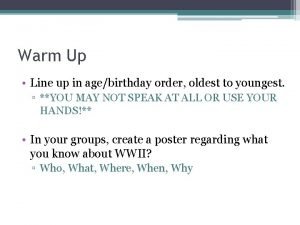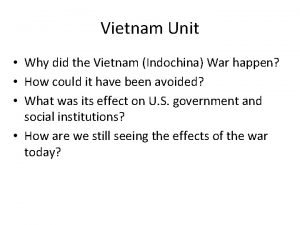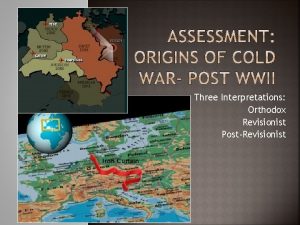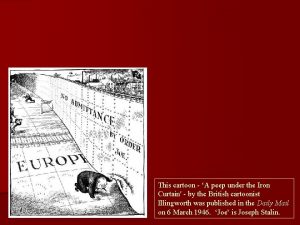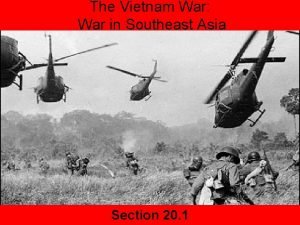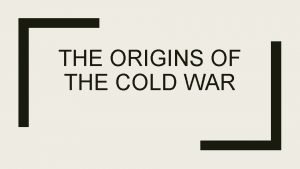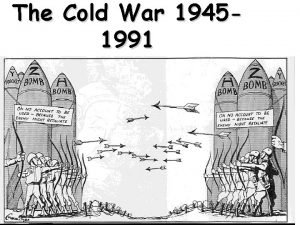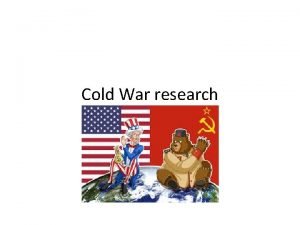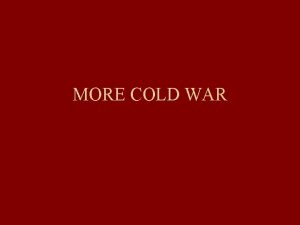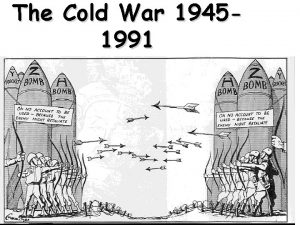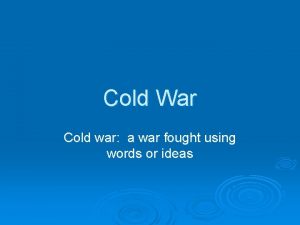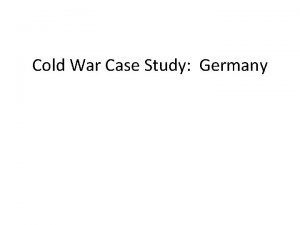CASE STUDY THE IMPACT OF THE COLD WAR











- Slides: 11

CASE STUDY; THE IMPACT OF THE COLD WAR ON YUGOSLAVIA P. 55 THE MAP OF YUGOSLAVIA BETWEEN 1945 AND 1990

CHANGE AND SIGNIFICANCE • The Background: History and Situation during WWII • Resistant groups: Chetniks ( royalists, Serbian) and Partisans ( Tito; communists) • In 1945: a federal government; Tito became PM • Socialism: six socialist republics: B-H. , C. , Macedonia, Montenegro, Serbia ( two autonomous provinces Kosovo, Vojvodina), Slovenia • Ethnic differentiation ( compare to the Habsburg Empire) • Universal suffrage, non-communist parties could not nominate candidates for the C. A elections. . • A communist victory

RELATIONS BETWEEN 1945 -48; TENSIONS? • Tito´s approach to the Soviet Union; an ally but not a puppet ( like satellite states) • The Trieste Question; should it be given to Italy, Yugoslavia or to create a free territory of Trieste under UN govern? • The region divided into two zones; Trieste not given to Y. , however Tito received zone B, US and Britain were given Zone A • Trieste to be an independent city under UN govern • USA and BRITAIN not welcomed, Tito´s partisans favored by the people. . • Tensions…

MORE TENSIONS BETWEEN Y. AND WESTERN COUNTRIES AND THE SOVIET UNION • Greek Civil War; communists ( Albania, Bulgaria +Tito´s help) against royalists ( Britain) • The Truman doctrine, 1947 : Tito became angry about Stalin´s lack of assistance to Greek Communists ( who also turned against Tito) • Tensions between the US and Yugoslavia; airspace incidents, violations, made also Stalin angry. . Tito working alone!

• Tito´s idea of The Balkan Federation: Albania, Bulgaria and Yugoslavia would share same ideology and could so form a federation • USA opposed the idea • Stalin liked it, but was cautious and wanted a federation which would follow The Moscow rules; did not Fit to Tito´s plans and no agreement was made

THE FINAL SPLIT ; SOVIET-YUGOSLAV , 1948 • Yugoslavia expelled from Cominform • An economic blockade on Y. by all Cominform countries ( no credits, no goods) • Stalin wanted to get rid of Tito, who was not following the rules • Unrest in Y. , split of the communist party; Tito´s consolidation of power • Y. was to follow its own path of communism!

FOREIGN RELATIONS BETWEEN 1948 -1980 -2008 • The Cold war was seen as an opportunity; Tito became the European leader in close contact with the non-aligned movement • No isolation; trade contacts important, reconciliation with the West • USA gave military assistance and Financial help ( Marshall aid): Tito able to create autonomy in the Socialist world • The death of Stalin resumed relations with the Eastern European countries; Y. was to have good relations with both East and West • The Bandung Conference and Belgrad C. in 1961; principles p. 85: Tito valued the Non-Aligned movement very high!

• Khrushchev ended the embargo, visited Y. and re-established relations with Tito • Y. was a unique socialist country throughout the Cold war; trading with both sides, following its own path • After Tito´s death in 1980 Y. relied on US assistance • The end of the cold war paved the way for the collapse of Yugoslavia; lost it strategic advantage as the bridge between East and West • Tensions among nationalities; In 1990 Slovenia started to process of dissolution of Y. in 1992 five successor states : B-H. , C, Macedonia, Slovenia, Serbia& Montenegro ( until 2006) • Questions on Kosovo and Vojvodina ( Serbia considers those autonomous regions)

COLD WAR AND Y. ´S DOMESTIC APPROACH • After WII; the Soviet model; nationalization, Soviet constitution of 1936 • The role of the Secret Police: State Security Administration: axis collaborators, non-communists to be hunted down! • UN relief • FYPS ; state ownership, Federal Planning Commission • Collectivization ( especially axis collaborators lost their land) , but still land belonged to those who cultivated it • A third way between communism and capitalism (“ people´s councils”)

• The idea of workers´ self-management; to boost the economy and inspire people to do their best • The constitution of 1963: separated the government from the communist party: more personal freedoms and human rights to the population. • Decentralization • Establishment of market socialism: workers owned their firms and shared their profits • Y. ´s quality of life was comparable to Western Europe

• In 1970´s more decentralization • Central control of the economy and on the other hand devolution of responsibility to the republics: impossible to achieve! • National grievances after Tito´s death, 1980 onwards. .
 The cold war begins lesson 1
The cold war begins lesson 1 Proxy wars during the cold war
Proxy wars during the cold war Best case worst case average case
Best case worst case average case Foxmeyer erp failure case study
Foxmeyer erp failure case study Biome desert location
Biome desert location Chapter 7 lesson 4 the war's impact
Chapter 7 lesson 4 the war's impact Acrostic poem for soviet union
Acrostic poem for soviet union Napalm vietnam war
Napalm vietnam war Postrevisionist
Postrevisionist The iron curtain cartoon analysis
The iron curtain cartoon analysis Operation rolling thunder cold war
Operation rolling thunder cold war Causes of the cold war
Causes of the cold war






